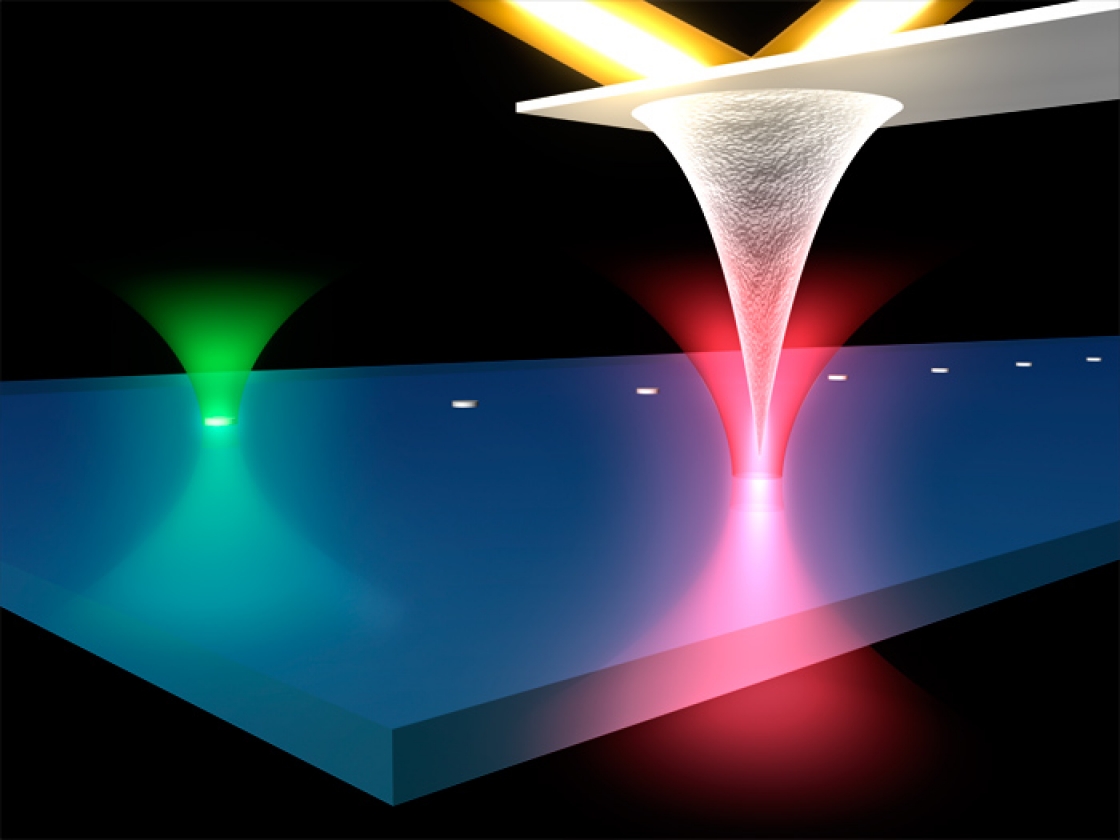The most important step for a microscope wanting to marry another microscope is finding the right partner. A professional matchmaker, such as the Perkins lab, might be just the ticket. The group recently presided over the nuptials of atomic force microscopy and optical-trapping microscopy. Research associate Gavin King, graduate students Ashley Carter and Allison Churnside, CU freshman Louisa Eberle, and Fellow Tom Perkins officiated. The marriage produced an ultrastable atomic force microscope (AFM) capable of precisely studying proteins in real-world (ambient) conditions.
The recently married AFM is a hundred times more stable than other state-of-the-art AFMs, one of the most widely used tools in nanoscience. However, using just AFM technology to probe a protein under ambient conditions is a lot like trying to write a letter while careening along a back country road in a jeep. There’s just a whole lot of movement happening at room temperature in either the air or liquids where biomolecules are found.
By adopting techniques developed in the Perkins lab, King and his colleagues are now in a position to secure a protein to a laser-stabilized surface, then hold an AFM tip above specific parts of that protein as a second laser measures the motion of the tip. This procedure is expected to allow the researchers to monitor a biomolecule’s conformational dynamics in real time, while canceling out the unwanted motion that obscures such measurements in conventional instruments. The new microscope is analogous to the "noise-canceling headphones" popular on noisy airplane flights.
In a recent "proof-of-concept" experiment, the Perkins group demonstrated a hundredfold improvement in the stability of AFM measurements of test targets consisting of 5 mm gold balls, which have a geometry and size similar to proteins. The researchers were able to make precise measurements at the length scale of an oxygen–hydrogen (OH) bond, or about 1 angstrom.
This marriage of laser science and precision measurement with atomic force microscopy will benefit many fields, including single-molecule biophysics, dip-pen lithography, and nanoengineering. Today, thousands of research groups use AFMs, and many could benefit from the use of an optically stabilized AFM to enable tip-sample stabilization and registration for extended periods of time. The Perkins lab plans to develop the new technology to study the folding and unfolding dynamics of membrane proteins, which are targets for 50% of all drugs. - Julie Phillips



 The Physics Frontiers Centers (PFC) program supports university-based centers and institutes where the collective efforts of a larger group of individuals can enable transformational advances in the most promising research areas. The program is designed to foster major breakthroughs at the intellectual frontiers of physics by providing needed resources such as combinations of talents, skills, disciplines, and/or specialized infrastructure, not usually available to individual investigators or small groups, in an environment in which the collective efforts of the larger group can be shown to be seminal to promoting significant progress in the science and the education of students. PFCs also include creative, substantive activities aimed at enhancing education, broadening participation of traditionally underrepresented groups, and outreach to the scientific community and general public.
The Physics Frontiers Centers (PFC) program supports university-based centers and institutes where the collective efforts of a larger group of individuals can enable transformational advances in the most promising research areas. The program is designed to foster major breakthroughs at the intellectual frontiers of physics by providing needed resources such as combinations of talents, skills, disciplines, and/or specialized infrastructure, not usually available to individual investigators or small groups, in an environment in which the collective efforts of the larger group can be shown to be seminal to promoting significant progress in the science and the education of students. PFCs also include creative, substantive activities aimed at enhancing education, broadening participation of traditionally underrepresented groups, and outreach to the scientific community and general public.